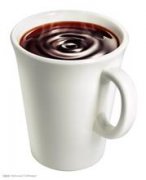The oldest coffee: a brief introduction to the flavor, taste and aroma characteristics of Yemeni mocha coffee

A long time ago, Ethiopians ruled what is now Yemen and transplanted coffee to Yemen. later, Arabs ruled the entire Arabian Peninsula, and Yemen was also among them. Natural energy coffee also became an Arab drink. In order to monopolize the product of coffee, the export of coffee beans had to be ironed so that they could not sprout. At that time, the port of coffee export was the port of Mocha. As a result, the name mocha coffee has been handed down to this day.
Due to the relatively dry environment in Yemen and the lack of water for coffee treatment, all coffee treatments in Yemen are sun-treated, which maximizes the fruity flavor of the coffee, but also causes a certain miscellaneous flavor. it may also cause instability in quality eventually. The Yemeni mocha coffee has a strong cocoa flavor, a red wine-like fermentation smell, a light fruit aroma, a taste of milk chocolate and a moderate mellowness, but due to the poverty and harsh climate in Yemen, the production of authentic mocha coffee is getting less and less, so the best mocha coffee is expensive.
It is difficult for Americans to forget the taste of mocha coffee after drinking mocha coffee at first, but when mocha coffee is decreasing, in order to make people remember the taste of mocha coffee, chocolate or chocolate sauce is added to the coffee to show the milk chocolate flavor of mocha. but in fact, fancy mocha coffee has nothing to do with real mocha coffee.
The common Yemeni mocha coffee shows that there is Mattari,Sananni. In fact, Mattari is the most common name of the Yemeni mocha. At first, it only refers to the coffee from Bani Matar, which has high acidity, but now the coffee beans from many other regions are also mixed with the coffee beans here to get a better price, which also affects the quality stability of Mattari. Sanani is mainly coffee from the west of the Yemeni capital Sana'a. Sanani coffee has soft acidity, good taste uniformity and moderate mellowness.
Mocca Sanani is produced in the surrounding area of Sana'a. Because of its full-sun treatment, the coffee product is not very good. The raw beans are yellowish and slightly green. Since the Ethiopians introduced coffee, Yemeni coffee has been the original coffee of Arabica since it was introduced by Ethiopians. It has been mixed with Arabica coffee. The bean shape is small, the uniformity is poor, and the defect rate is high. It needs to be carefully selected before baking. Since Yemen is a very poor country, the coffee produced there is also organic.
I personally prefer Yemeni coffee in taste. After testing, we choose medium and shallow roasting. The dried aroma after grinding has a hay flavor. Later, fresh fruit aroma will appear, which is very light, but it is completely different from the dry aroma of the previous paragraph. So it's easy to find. When filled, the wet aroma has a hint of peanuts and nuts. The taste is bitter, but it immediately turns to the sweetness of milk chocolate. Some of the consequences of the drop in temperature are more obvious, much like the faint fruit aroma of wine, with cocoa flavor at the back end and moderate mellowness. Although it is tanned coffee, it tastes as clean as washed coffee after drinking.
If you use short words to describe this mocha coffee, I would say that it is an authentic coffee flavor, inheriting the tradition, and there is no lack of freshness and elegance. It is definitely a good coffee that you can't miss as a coffee lover.
Before the 6th century AD, Yemen was called Arabia, so coffee trees shipped from Yemen to other places were also called Arabian coffee trees. But the origin of these trees is Ethiopia, and the Dutch spread these coffee trees around the world. Dutch businessmen sailing eastward around the Cape of good Hope (The Cape Of Good Hope) travel across the east coast of Africa to the port of Mocha in Yemen before they begin their long trek to India. In 1696, the Dutch introduced coffee trees to Ceylon (now Sri Lanka) and then to Batavia in Java.
Mocha beans are smaller and rounder than most, which makes mocha beans look like peas-in fact, bean-shaped berry coffee beans (Peaberrybean) are sometimes called mocha beans. Mocha beans are similar in shape to Ethiopia's Harrar coffee beans, with small particles, high acidity and a strange and indescribable spicy flavor. Taste carefully, but also can distinguish a little chocolate flavor, so the attempt to add chocolate to coffee is a very natural process of development.
In Yemen, coffee growers plant poplars to provide shade for coffee to grow. As in the past, these trees are planted on steep terraces to maximize the use of less rainfall and limited land resources. In addition to the Tippika Coffee Tree and the Bourbon Coffee Tree, more than a dozen different coffee species native to Ethiopia are grown in Yemen. However, even the best coffee, such as premium mocha, is air-dried and the peel is connected to the beans. Until now, Yemen often uses traditional stone mills to remove dry and hard shells, which makes the shape of coffee beans very irregular and often damages them.
Despite the high quality and smooth aroma of Yemeni coffee, there is something unsatisfactory, that is, the quality can not be continuously guaranteed, and the classification of its coffee beans is uncertain. Traditionally, the best coffee beans in Yemen come from Mattari, followed by Sharki, followed by Sanani. These beans are low in caffeine and are exported from December to April of the following year. The problem in the past has been that coffee from the north was mixed with shoddy stuff before it was shipped from the southern port of Aden. Only coffee shipped from the port of Hodeida can be determined to come from the north. The vast majority of Yemeni coffee is grown in natural conditions, mainly due to the lack of funds for growers.
Yemeni mocha is one of the oldest coffee in the world, but until recently, Yemeni mocha has come to be regarded as one of the best and most delicious coffee in the world. Mocha coffee, which has a long history, is synonymous with coffee. Its unique aroma and sour taste have deeply attracted many coffee lovers.
The name mocha comes from Mocha in Yemen, a port that can no longer be used]. It has almost been filled with sand, no longer a port, but a sandbar.
As a kind of individual coffee, Yemeni mocha has a unique charm and a long history.
Before the 6th century in the park, Yemen was called Arab, so the coffee trees transported from them to other places were also called Arabian coffee trees.
Yemen is the first country in the world to produce coffee on a large scale as a crop. The method of cultivation and treatment of mocha coffee in Yemen today is basically the same as that of hundreds of years ago. On most coffee farms in Yemen, coffee farmers still resist the use of artificial chemicals such as chemical fertilizers. Coffee farmers plant poplars to provide shade for coffee to grow. As in the past, these trees are planted on steep terraces to maximize the use of less rainfall and limited land resources. What is more unique is that Yemeni mocha beans are still shipped in a bag made of straw, rather than chemical woven bags in other places. If you are a pure naturalist, the Yemeni mocha can satisfy your desire to drink coffee that has been completely natural.
Mocha beans are smaller, rounder and light green than most coffee beans, which makes mocha beans look more like peas. Mocha beans are similar in shape to Ethiopia's Harald beans, with small particles, high acidity and a strange and indescribable spicy flavor. Taste carefully, but also can distinguish a little chocolate flavor, so the attempt to add chocolate to coffee is a very natural process of development.
Mocha coffee is characterized by its fruity flavor, with obvious wine, spicy and nutty flavors. Some people say that Yemeni mocha tastes like blueberries, while others say it is a "wild flavor" peculiar to the Red Sea.
The price of Yemeni coffee in the international market has not been low, mainly because Yemeni coffee is very popular in countries and regions where "Turkish" coffee is popular. In Saudi Arabia, the Yemeni mocha is so spoiled that people there are willing to pay a high price for low-quality mocha coffee. This special fondness for mocha keeps the price of mocha coffee high in the world coffee market.
If Mexican coffee can be compared to dry white wine, then Yemeni mocha is Bordeaux wine.
In fact, the word mocha comes from the southwestern part of the Asian continent, the southwestern tip of the Arabian Peninsula, a port across the sea from Africa. The port of Mocha now belongs to the Republic of Yemen, one of the poorest countries in the world. Mocha coffee here is regarded as a treasure by coffee lovers all over the world, which can be found but not sought, if they claim to love coffee but have never tasted authentic Yemeni mocha coffee. That's not the biggest regret for coffee lovers.
Important Notice :
前街咖啡 FrontStreet Coffee has moved to new addredd:
FrontStreet Coffee Address: 315,Donghua East Road,GuangZhou
Tel:020 38364473
- Prev

A brief introduction to the treatment method of grinding degree and baking degree of Kilimanjaro coffee beans in Tanzania
There are three main types of coffee machines in common use. Drip filter: wet the coffee powder with water and let the coffee liquid flow through the filter cloth or filter paper and flow into the container at the speed of natural fall. Basically, this method does not soak the coffee powder, just let the hot water pass slowly through the coffee powder. Both the drip filter cup and the electric coffee maker fall into this category and are the simplest brewing tools that can soak clean and colored.
- Next

Brief introduction of Yemeni Mocha single boutique Coffee Bean planting Market Price
It is difficult for Americans to forget the taste of mocha coffee after drinking mocha coffee at first, but when mocha coffee is decreasing, in order to make people remember the taste of mocha coffee, chocolate or chocolate sauce is added to the coffee to show the milk chocolate flavor of mocha. but in fact, fancy mocha coffee has nothing to do with real single mocha coffee. A common Yemeni mocha coffee watch
Related
- Detailed explanation of Jadeite planting Land in Panamanian Jadeite Manor introduction to the grading system of Jadeite competitive bidding, Red bid, Green bid and Rose Summer
- Story of Coffee planting in Brenka region of Costa Rica Stonehenge Manor anaerobic heavy honey treatment of flavor mouth
- What's on the barrel of Blue Mountain Coffee beans?
- Can American coffee also pull flowers? How to use hot American style to pull out a good-looking pattern?
- Can you make a cold extract with coffee beans? What is the right proportion for cold-extracted coffee formula?
- Indonesian PWN Gold Mandrine Coffee Origin Features Flavor How to Chong? Mandolin coffee is American.
- A brief introduction to the flavor characteristics of Brazilian yellow bourbon coffee beans
- What is the effect of different water quality on the flavor of cold-extracted coffee? What kind of water is best for brewing coffee?
- Why do you think of Rose Summer whenever you mention Panamanian coffee?
- Introduction to the characteristics of authentic blue mountain coffee bean producing areas? What is the CIB Coffee Authority in Jamaica?

